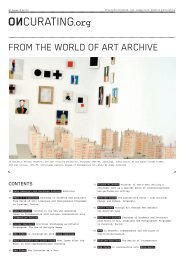Create successful ePaper yourself
Turn your PDF publications into a flip-book with our unique Google optimized e-Paper software.
03 Issue # 11/11 : PublIc Issues<br />
the tree-lined<br />
road to euroPe.<br />
socio-economic<br />
imPlications<br />
of Zurich's main<br />
station euroPaallee<br />
Project<br />
Richard Wolff<br />
Introduction<br />
Europaallee is Zurich's largest inner city development.<br />
It is located right next to the main station and serves <strong>as</strong><br />
an extension of the central business district of Bahnhofstr<strong>as</strong>se.<br />
Currently under construction, Europaallee will be<br />
a mixed-use development, with offices, apartments, shops,<br />
and the teacher training college. Because of the project's<br />
unique scale and location, it is of utmost importance for<br />
Zurich's urban development. Never before in Zurich h<strong>as</strong><br />
there been a comparable project for inner city development 1 .<br />
And never since the latter half of the 19th century, when<br />
the city w<strong>as</strong> dramatically transformed by industrialisation<br />
and railways (Bärtschi 1983), h<strong>as</strong> Zurich seen such a<br />
thorough intervention in its city centre.<br />
This article focuses on the multiple contradictions<br />
of large-scale urban development projects. It analyses the<br />
various stakeholder interests, their socio-economic envi-<br />
ronment, and the final outcome of the project. To better<br />
understand the prerequisites of the current process, it is<br />
necessary to briefly go back 40 years and to explain the<br />
preliminary ph<strong>as</strong>es of today's scheme.<br />
Origins of the plan and cross-national references<br />
The first ide<strong>as</strong> for developing Zurich's main station date<br />
back to the 1960s. Zurich w<strong>as</strong> in the middle of an economic<br />
boom and w<strong>as</strong> lacking office space in the city centre<br />
(Hitz et. al. 1995). At the same time, SBB (Swiss Federal<br />
Railways) 2 were intending to renew and enlarge their station.<br />
In return for selling the air rights above the tracks,<br />
SBB expected private investors to finance a new station and<br />
to generate extra rental income.<br />
Zurich's idea w<strong>as</strong> not unique. In many cities, railway<br />
companies and city planners, often in conjunction with pri-<br />
vate developers, had developed similar ide<strong>as</strong>. In Europe,<br />
well-known examples of similar projects are Gare de Mont-<br />
parn<strong>as</strong>se in Paris or Liverpool Street Station (Broadgate)<br />
in London, Euralille in Lille, and Euro Ville in B<strong>as</strong>el<br />
(Bertolini 1998 and Peters Deike 2009).<br />
Corner stones of HB Südwest and Eurogate<br />
Between 1969 and 2002, plans to build across Zurich's main<br />
station tracks came in ever-changing guises (fig. 1). First<br />
labelled HB Südwest (Main Station Southwest), then Eurogate 3 ,<br />
the project's appearance and contents varied time and<br />
again. The core uses in all<br />
versions were the extension<br />
of the station and a new com-<br />
muter station, a pedestrian<br />
p<strong>as</strong>sage, offices and shopping<br />
facilities. Other uses<br />
that, over time, were pro-<br />
posed, added, enhanced, en-<br />
larged, reduced, or cancelled<br />
included housing, hotels,<br />
and schools. All the projects<br />
would have cost between 1<br />
and 1.5 billion Swiss francs<br />
offering a total floor space<br />
of between 250'000 and<br />
400'000 m 2 .<br />
Some versions included high-<br />
rise buildings, a hotel, and<br />
large auditoriums; others<br />
featured town squares, a car<br />
park, or up to 310 flats in-<br />
corporated on the deck across<br />
the railway tracks. Only in<br />
the very first project would<br />
the historic station building<br />
have been demolished; but<br />
then, in 1972, it w<strong>as</strong> listed<br />
<strong>as</strong> an historic monument and<br />
therefore protected under a<br />
conservation order.<br />
Each of the project's ph<strong>as</strong>es<br />
w<strong>as</strong> managed by a different<br />
alliance of developers. Only<br />
SBB w<strong>as</strong> always a member. At<br />
first, in 1969, it w<strong>as</strong> an<br />
alliance of purely public and<br />
semi-public agencies, con-<br />
sisting of the Swiss Federal<br />
Railways, the Canton of<br />
Zurich, the City of Zurich,<br />
and the Federal Post Office.<br />
After 1978, various publicprivate<br />
partnerships in-<br />
cluding Switzerland's largest<br />
banks, insurers, 4 contrac-<br />
tors, 5 and other large corpo-<br />
rations reinitiated the<br />
project.<br />
The City of Zurich – crucial<br />
<strong>as</strong> a planning authority – w<strong>as</strong><br />
not always part of the con-<br />
sortia. City government<br />
changed its stance several<br />
times. Until about 1973 an<br />
overt supporter, the city w<strong>as</strong><br />
first stopped by a referen-<br />
dum and then, after a po-<br />
litical shift, its attitude<br />
became critical of growth.<br />
For many years, Ursula Koch,<br />
Head of the City Building<br />
Department, and supported by<br />
an important share of the<br />
population, w<strong>as</strong> responsible<br />
for slowing down the planning<br />
process. Only after the<br />
neoliberal shift of 1994<br />
did the City of Zurich again<br />
1<br />
Only transport in-<br />
fr<strong>as</strong>tructure<br />
schemes like the<br />
motorway-Y and the<br />
underground rail-<br />
way are larger in<br />
size (Schweingruber<br />
1986, Lin-<br />
denmeyer 1986,<br />
Senter for Applied<br />
Urbanism 1986,<br />
Kammerer 1986).<br />
2<br />
In this text,<br />
I use the German<br />
acronyms of natio-<br />
nal institutions,<br />
thus Swiss Federal<br />
Railways for SBB<br />
i.e., Schweizeri-<br />
sche Bundesbahnen.<br />
3<br />
Eurogate w<strong>as</strong> ob-<br />
viousliy an allu-<br />
sion to Zurich's<br />
gate towards Eu-<br />
rope and not<br />
to the Watergate<br />
fi<strong>as</strong>co.<br />
4<br />
HB City Immobilien<br />
AG w<strong>as</strong> established<br />
in 1981, and con-<br />
sisted of the then<br />
four largest Swiss<br />
banks Swiss Bank<br />
Corporation, Union<br />
Bank of Switzerland,<br />
Credit<br />
Suisse, Cantonal<br />
Bank of Zurich,<br />
two of Switzerland's<br />
largest in-<br />
surers (Zurich and<br />
Pax), and various<br />
large electrotechnical<br />
and con-<br />
struction compa-<br />
nies (POCH 1987).<br />
5<br />
Karl Steiner Immo-<br />
bilien AG, Göhner<br />
Merkur AG, and<br />
Bührle Immobilien<br />
AG.


![Download as PDF [10.6 MB]](https://img.yumpu.com/4266533/3/500x640/download-as-pdf-106-mb.jpg)

